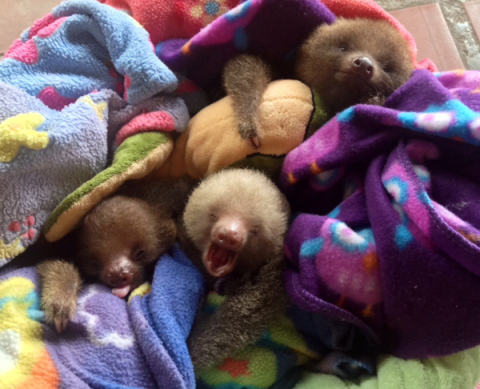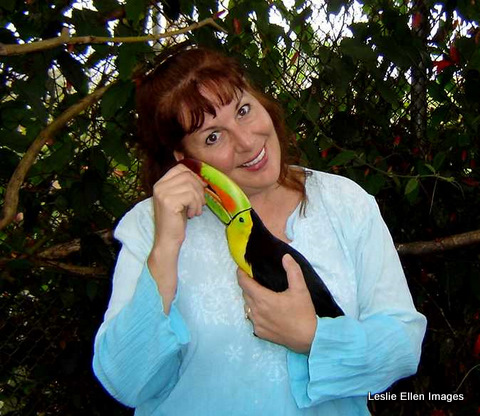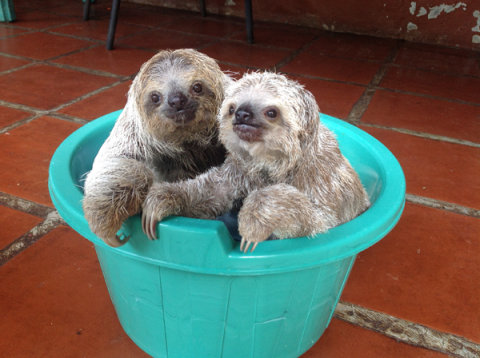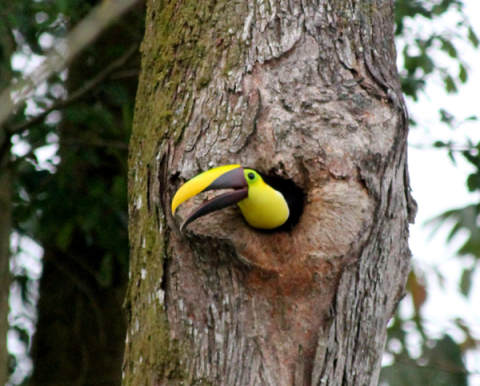
“Can you hear them?” she asks. We can.
The Toucan Rescue Ranch is located in San Isidro, in the province of Heredia, about 20 minutes from downtown San Jose. It was founded by Howle in 2004 and currently houses some 150 animals; toucans, yes, but also owls, anteaters, sloths, porcupines and kinkajous. The three “R’s” of the ranch’s mission are to rescue, rehabilitate and, if possible, release the animals that come into her care back into the wild.
American by birth, Howle spent the years between ages seven and 15 in Costa Rica. Her father was a property developer working in the country. She then moved back to the U.S. with her family but returned to South America “a million years later” to visit.
It was then that Howle got involved with the Tambopata Macaw Project in Peru. After two months with them she did a stint with another macaw program, Amigos de las Aves (Friends of the Birds) in Costa Rica. Howle soon concluded that the macaws “basically had it made because there were all these people looking out for them and they all had great programs to go to.” People, by contrast, were not “the slightest bit interested” in Costa Rica’s toucans so Howle decided to do something about it.
“Toucans in Costa Rica were always on the backburner for people for rescue,” she says. “Always the focus was on macaws because they were listed as endangered. And when I started the Toucan Rescue Ranch 11 years ago, it was obvious from the pet trade that certainly toucans were headed in the same direction as macaws, to be on the endangered species list.”

To illustrate the latter point, Howle tells of an German tourist, Maciej Oskroba, a herpetoculturist (a person who keeps repiles in captivity in order to breed them) arrested last September for trying to smuggle 184 frogs, 42 lizards, nine snakes and 203 tadpoles out of the country in his luggage. While jail time is an option for this offense, it is rarely imposed. Oskroba was instead deported.
Howle cites a more personal example when it comes to the problem of habitat loss.
“We have three active nests of toucans that we know about,” she says. “Two of them are actually on our property and one is on a property in town. I say town, but it’s 25 houses, a village. There is a toucan nest that has been very active year after year, and we just found out this morning that the owner, because it’s a big parcel of trees, sold all the trees, and today they’re going in with a chainsaw to tear them down.
“So I just said to [the owner’s son] ‘Call your dad and ask him how much he wants for that one tree with the nest.’ And I’m going to go online and do my best to buy that one tree back, to save that one tree with the nest. And that’s happening today and tomorrow.” In a follow-up email to Samaritanmag Howle says they managed to save not only that tree but “several trees all surrounding the nest. Yippee!”
Of the ranch’s three principles — rescue, rehabilitation and release — Howle, an occupational therapist by trade, says the primary focus is on release of the animals back into the wild, although that is directly tied into how well they can be rehabilitated. In terms of rescue, animals are often brought in by concerned citizens or wildlife and park officials.

Making release even more difficult are the emotional bonds that can develop between Howle and the animals. She tells the story of a recently-released eight-month-old three-toed sloth. It had fallen out of a tree, and its mother, who would have left her baby to its own devices in another month anyway, had taken ill and died. Howle named her Angel
“She was one where there was a bit of a debate: do we try to release her? Do we keep her? What do we do? She’s not used to people, though; she’s used to being out in the wild. And so she would be one that most people would make an excuse to keep in captivity.”
With its injuries healed, Howle ended up paying a friend to stay at the release site and track Angel’s return to the wild.
“Every day he goes out and finds her, and she’ll disappear for three days and then he’ll find her again. She’s in the trees and doing very well. And so that was really exciting for us because for me it took a lot of guts to let her go because I don’t have a GPS system; that’s something that we really, really need is the little GPS backpacks that we can put on them and have somebody track them. Here we’re just tracking them by eyesight. So it becomes a little more complicated, but she’s doing really well.”
Howle works seven-day weeks, dealing with hands-on emergencies (including caring for the “little tiny babies” who come in), day-to-day feedings and the cleaning of cages. Assisting Howle in her efforts is co-director (and husband) Jorge Murillo and a small but dedicated staff. The ranch has also started taking on so-called ‘voluntourists’ — tourists interested in spending at least a month on the ranch working (there are several housing options listed on the web site). Duties include cleaning cages, feeding, and providing comfort to cute animals.

“We do ask for a month commitment from them so that we know that they’re going to be here every day and are committed to be here for the hours so we can actually rely on them. The volunteers who were coming for just one week or two weeks, they’d find other things to do. So they would say they would show up but then would not show up, so that to us was more work. But now that we have it changed to a one-month minimum, we’re getting people who are committed and interested. It’s been great.”
While Howle says that she has a good working relationship with Costa Rica’s Ministry of the Environment, Energy and Technology (MINAE), the department responsible for the country’s wildlife, they only license private rescue organizations; they do not fund them. Instead the ranch relies on monies generated from donations, two bed-and-breakfast apartments, daily tours, and online funding campaigns. This month Howle will fundraise for an otter swimming pool with a waterfall. She also needs a digital microscope, as well as an X-ray and ultrasound machine.
I mention that a friend who recently volunteered at the ranch told me that some of Howle’s charges get to stay in her house. Who are those lucky animals, I ask? She laughs.
“Well, we have a clinic now so we have been trying to put animals over in the clinic. But usually the ones that stay in the house are the ones I have to do the 4 a.m. feedings for so I don’t have to actually go outside. So I’m doing midnight and 4 a.m. feedings for six baby sloths right now so those are the ones inside.”
Sneakers